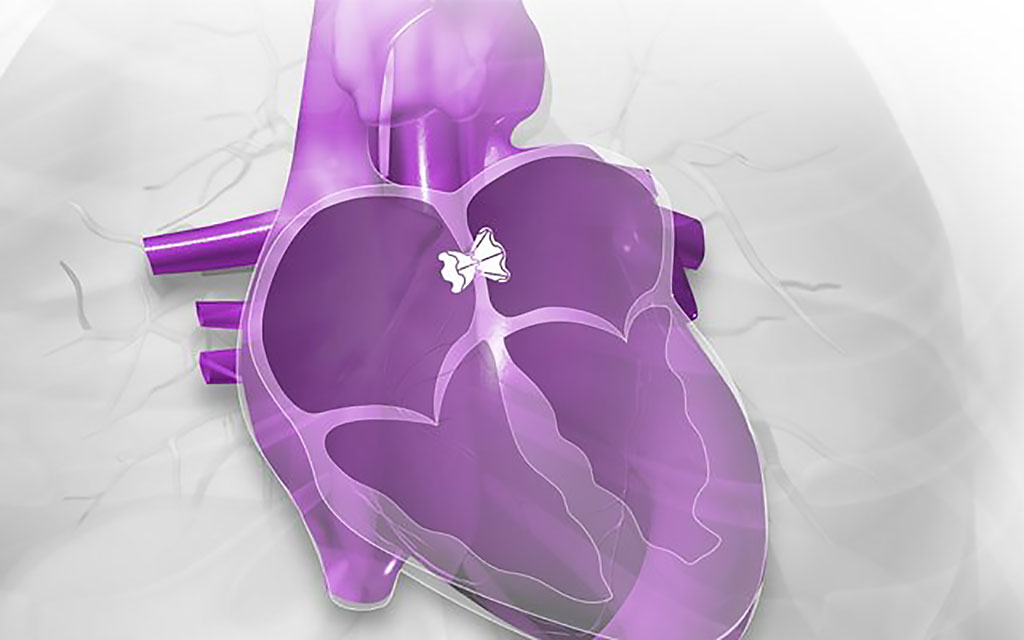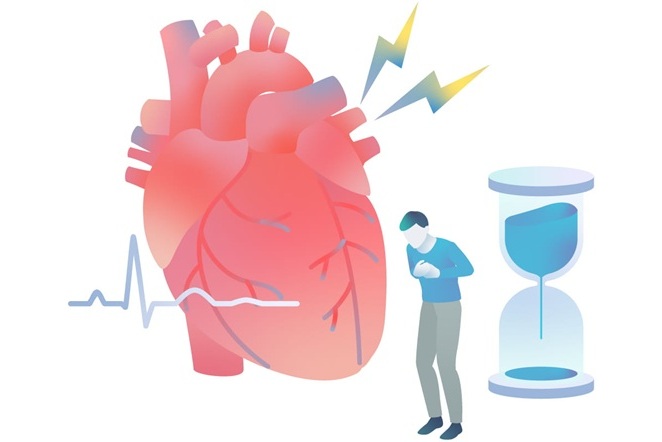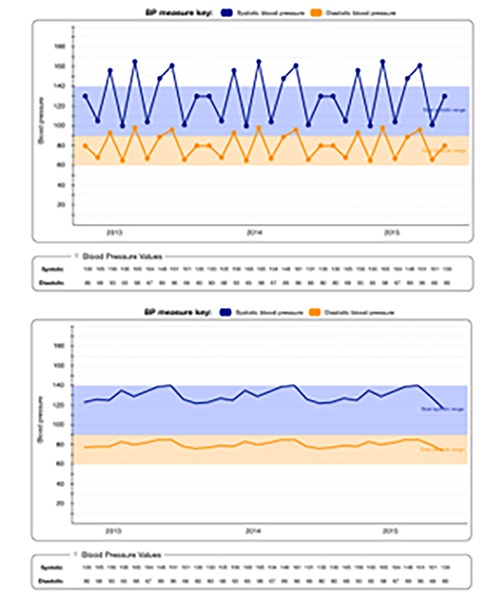Interatrial Shunt System Relieves Heart Failure Symptoms
|
By HospiMedica International staff writers Posted on 19 Mar 2020 |

Image: The Ventura interatrial shunt system implant (Photo courtesy of V-Wave)
A novel interatrial shunt controls elevated left atrial pressure (LAP) in order to prevent pulmonary congestion and hospitalizations in chronic heart Failure (HF) patients.
The V-Wave (Caesarea, Israel) Ventura shunt system is composed of a miniature biocompatible interatrial implant and a dedicated delivery system. The implant is designed to regulate LAP by straddling the interatrial septum and forming a conduit that connects left and right atria, allowing continuous, dynamic decompression of the left atrium at rest and physical activity. The device is placed through the fossa ovalis in a minimally invasive cardiac catheterization procedure, using the proprietary delivery catheter.
The Ventura Interatrial Shunt is being evaluated in a global, randomized, controlled, double-blinded, 500 patient pivotal trial called RELIEVE-HF, which is designed to demonstrate safety and effectiveness of shunt therapy in reducing HF morbidity and mortality and improving functional status. The study is enrolling advanced HF patients with preserved or reduced left ventricular ejection fraction (LVEF) who remain symptomatic, despite the use of guideline-directed medical and device therapies. Approximately 100 of the top hospitals in North America, Europe, and Israel are or will be participating.
“More than 26 million people suffer from chronic heart failure worldwide, and HF remains a leading driver of disability and acute hospitalization, particularly in the growing elderly population,” said William Abraham, MD, chief medical officer at V-Wave. “The minimally invasive implanted Ventura interatrial shunt relieves excessive pressure in the left side of the heart, thereby reducing the build-up of fluid in the lungs, which is the most common reason for worsening HF symptoms, exercise limitation, and HF hospitalizations.”
There are two types of HF; HF with reduced ejection fraction (HFrEF, systolic heart failure), and heart failure with preserved or mid‐range ejection fraction (HFpEF/HFmrEF), previously called diastolic heart failure. HFpEF accounts for approximately 50% of all HF, but treatment options are limited, consisting mainly of diuretics and fluid balance control. Although the pathophysiology of HFpEF is complex, many of the symptoms are a result of excessive rises in LAP, in particular during exercise.
Related Links:
V-Wave
The V-Wave (Caesarea, Israel) Ventura shunt system is composed of a miniature biocompatible interatrial implant and a dedicated delivery system. The implant is designed to regulate LAP by straddling the interatrial septum and forming a conduit that connects left and right atria, allowing continuous, dynamic decompression of the left atrium at rest and physical activity. The device is placed through the fossa ovalis in a minimally invasive cardiac catheterization procedure, using the proprietary delivery catheter.
The Ventura Interatrial Shunt is being evaluated in a global, randomized, controlled, double-blinded, 500 patient pivotal trial called RELIEVE-HF, which is designed to demonstrate safety and effectiveness of shunt therapy in reducing HF morbidity and mortality and improving functional status. The study is enrolling advanced HF patients with preserved or reduced left ventricular ejection fraction (LVEF) who remain symptomatic, despite the use of guideline-directed medical and device therapies. Approximately 100 of the top hospitals in North America, Europe, and Israel are or will be participating.
“More than 26 million people suffer from chronic heart failure worldwide, and HF remains a leading driver of disability and acute hospitalization, particularly in the growing elderly population,” said William Abraham, MD, chief medical officer at V-Wave. “The minimally invasive implanted Ventura interatrial shunt relieves excessive pressure in the left side of the heart, thereby reducing the build-up of fluid in the lungs, which is the most common reason for worsening HF symptoms, exercise limitation, and HF hospitalizations.”
There are two types of HF; HF with reduced ejection fraction (HFrEF, systolic heart failure), and heart failure with preserved or mid‐range ejection fraction (HFpEF/HFmrEF), previously called diastolic heart failure. HFpEF accounts for approximately 50% of all HF, but treatment options are limited, consisting mainly of diuretics and fluid balance control. Although the pathophysiology of HFpEF is complex, many of the symptoms are a result of excessive rises in LAP, in particular during exercise.
Related Links:
V-Wave
Latest Surgical Techniques News
- DNA Origami Improves Imaging of Dense Pancreatic Tissue for Cancer Detection and Treatment
- Pioneering Sutureless Coronary Bypass Technology to Eliminate Open-Chest Procedures
- Intravascular Imaging for Guiding Stent Implantation Ensures Safer Stenting Procedures
- World's First AI Surgical Guidance Platform Allows Surgeons to Measure Success in Real-Time
- AI-Generated Synthetic Scarred Hearts Aid Atrial Fibrillation Treatment
- New Class of Bioadhesives to Connect Human Tissues to Long-Term Medical Implants
- New Transcatheter Valve Found Safe and Effective for Treating Aortic Regurgitation
- Minimally Invasive Valve Repair Reduces Hospitalizations in Severe Tricuspid Regurgitation Patients
- Tiny Robotic Tools Powered by Magnetic Fields to Enable Minimally Invasive Brain Surgery
- Magnetic Tweezers Make Robotic Surgery Safer and More Precise
- AI-Powered Surgical Planning Tool Improves Pre-Op Planning
- Novel Sensing System Restores Missing Sense of Touch in Minimally Invasive Surgery
- Headset-Based AR Navigation System Improves EVD Placement
- Higher Electrode Density Improves Epilepsy Surgery by Pinpointing Where Seizures Begin
- Open-Source Tool Optimizes Placement of Visual Brain Implants
- Easy-To-Apply Gel Could Prevent Formation of Post-Surgical Abdominal Adhesions
Channels
Critical Care
view channel
Breakthrough AI Technology Accurately Assesses Heart Failure Severity
Heart failure (HF) is a complex condition where the heart cannot effectively pump blood to meet the body’s needs due to underlying medical issues. It is marked by recurring episodes and frequent hospitalizations.... Read more
New Approach to Visualizing Blood Pressure Data Can Help Better Manage Hypertension Patients
Sometimes, a patient’s blood pressure may be elevated in a doctor's office but normal at home, a phenomenon known as white coat hypertension. It is estimated that 10% to 20% of high blood pressure diagnoses... Read morePatient Care
view channel
Portable Biosensor Platform to Reduce Hospital-Acquired Infections
Approximately 4 million patients in the European Union acquire healthcare-associated infections (HAIs) or nosocomial infections each year, with around 37,000 deaths directly resulting from these infections,... Read moreFirst-Of-Its-Kind Portable Germicidal Light Technology Disinfects High-Touch Clinical Surfaces in Seconds
Reducing healthcare-acquired infections (HAIs) remains a pressing issue within global healthcare systems. In the United States alone, 1.7 million patients contract HAIs annually, leading to approximately... Read more
Surgical Capacity Optimization Solution Helps Hospitals Boost OR Utilization
An innovative solution has the capability to transform surgical capacity utilization by targeting the root cause of surgical block time inefficiencies. Fujitsu Limited’s (Tokyo, Japan) Surgical Capacity... Read more
Game-Changing Innovation in Surgical Instrument Sterilization Significantly Improves OR Throughput
A groundbreaking innovation enables hospitals to significantly improve instrument processing time and throughput in operating rooms (ORs) and sterile processing departments. Turbett Surgical, Inc.... Read moreHealth IT
view channel
Printable Molecule-Selective Nanoparticles Enable Mass Production of Wearable Biosensors
The future of medicine is likely to focus on the personalization of healthcare—understanding exactly what an individual requires and delivering the appropriate combination of nutrients, metabolites, and... Read more
Smartwatches Could Detect Congestive Heart Failure
Diagnosing congestive heart failure (CHF) typically requires expensive and time-consuming imaging techniques like echocardiography, also known as cardiac ultrasound. Previously, detecting CHF by analyzing... Read moreBusiness
view channel
Expanded Collaboration to Transform OR Technology Through AI and Automation
The expansion of an existing collaboration between three leading companies aims to develop artificial intelligence (AI)-driven solutions for smart operating rooms with sophisticated monitoring and automation.... Read more

















